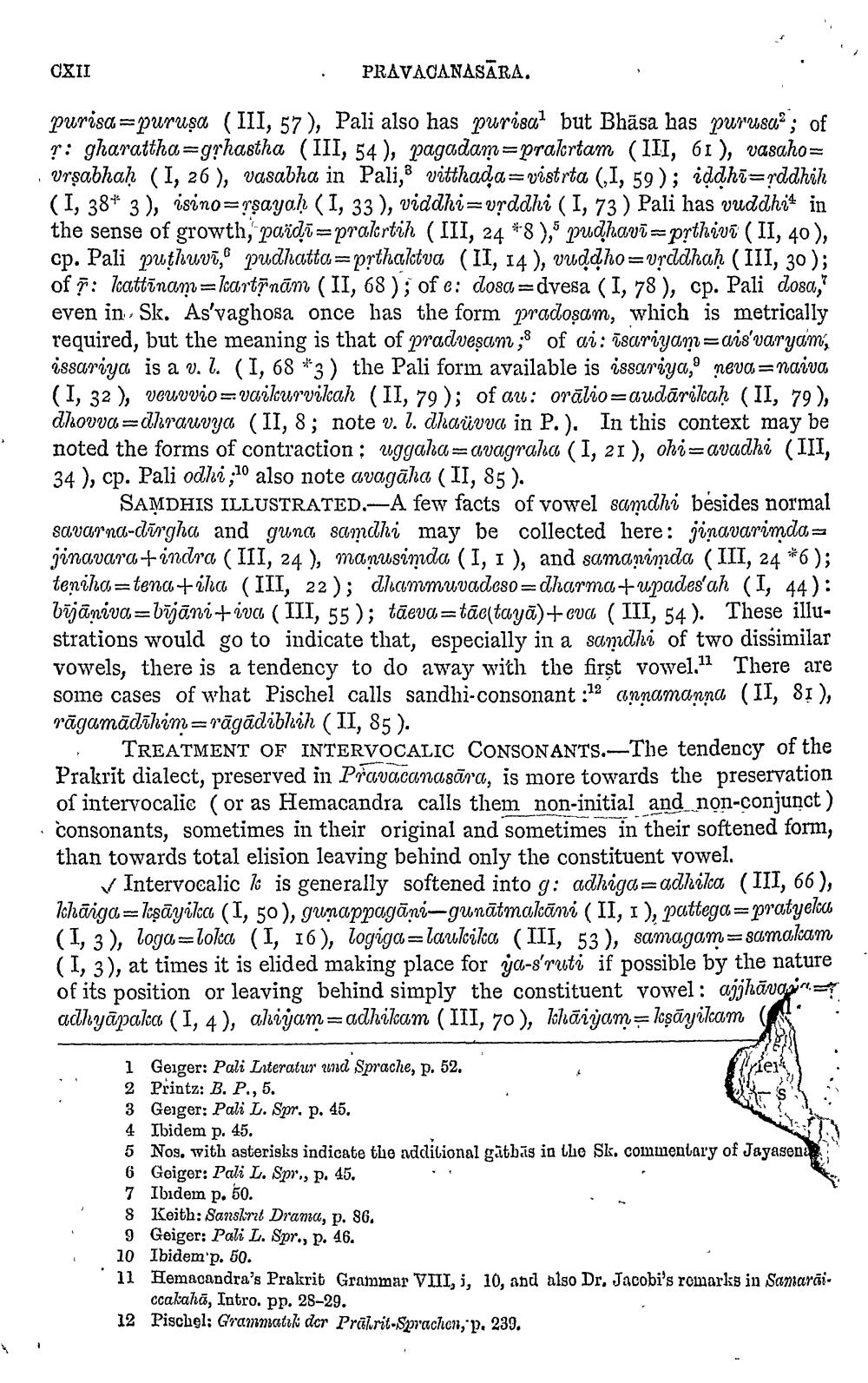________________
PRAVACANASĀRA.
==
purisa purusa (III, 57), Pali also has purisa1 but Bhasa has purusa2; of r: gharattha-gṛhastha (III, 54), pagadam=prakrtam (III, 61), vasaho= vrṣabhaḥ (1, 26), vasabha in Pali, vitthada vistrta (,1, 59); iḍḍhī=ṛddhih (I, 38* 3), isino=ṛṣayaḥ (I, 33 ), viddhi=vṛddhi ( 1, 73) Pali has vuddhi1 in the sense of growth, paidi prakrtih (III, 24 *8),5 pudhavī≈pṛthivī ( II, 40), cp. Pali puthuvi, pudhatta=prthaktva (II, 14), vuddhovṛddhaḥ (III, 30); of r: kattinam kartṛnām (II, 68); of e: dosa-dvesa (I, 78), cp. Pali dosa, even in Sk. As'vaghosa once has the form pradosam, which is metrically required, but the meaning is that of pradveṣam; of ai: isariyam=ais'varyam, issariya is a v. l. (I, 68 *3) the Pali form available is issariya, neva=naiva (I, 32), veuvvio vaikurvikah (II, 79); of au: orālio=audārikaḥ (II, 79), dhovva=dhrauvya (II, 8; note v. l. dhaüvva in P.). In this context may be noted the forms of contraction; uggaha=avagraha (1, 21), ohi=avadhi (III, 34), cp. Pali odhi,10 also note avagāha (II, 85).
CXII
SAMDHIS ILLUSTRATED.-A few facts of vowel samdhi besides normal savarna-dirgha and guna samdhi may be collected here: jinavarimda= jinavara+indra (III, 24), manusimda (I, 1), and samanimda (III, 24 *6); teniha tena+iha (III, 22); dhammuvadeso dharma+upades'ah (I, 44): bījāņiva=bījāni+iva (III, 55); tāeva=tāc(tayā)+eva (III, 54). These illustrations would go to indicate that, especially in a samdhi of two dissimilar vowels, there is a tendency to do away with the first vowel.11 There are some cases of what Pischel calls sandhi-consonant :12 annamanna (II, 81 ), rāgamādīhim rāgādibkih (II, 85 ).
TREATMENT OF INTERVOCALIC CONSONANTS.-The tendency of the Prakrit dialect, preserved in Pravacanasara, is more towards the preservation of intervocalic (or as Hemacandra calls them non-initial and non-conjunct) consonants, sometimes in their original and sometimes in their softened form, than towards total elision leaving behind only the constituent vowel.
✓ Intervocalick is generally softened into g: adhiga adhika (III, 66), khaigakṣayika (I, 50), gunappagāni-gunātmakani (II, 1), pattega=pratyeka (1, 3), loga loka (1, 16), logiga laukika (III, 53), samagam samakam (I, 3), at times it is elided making place for ya-s'ruti if possible by the nature of its position or leaving behind simply the constituent vowel: ajjhāva adhyapaka (1, 4), ahiyam-adhikam (III, 70), khaiyam kṣayikam
1 Geiger: Pali Literatur und Sprache, p. 52.
2 Printz: B. P., 5.
3 Geiger: Pali L. Spr. p. 45.
4 Ibidem p. 45.
=
=
5 Nos. with asterisks indicate the additional gathas in the Sk. commentary of Jayasena
6 Geiger: Pali L. Spr., p. 45.
7 Ibidem p. 50.
8 Keith: Sanskrit Drama, p. 86.
9 Geiger: Pali L. Spr., p. 46.
10 Ibidem p. 50.
11 Hemacandra's Prakrit Grammar VIII, i, 10, and also Dr. Jacobi's remarks in Samarāiccakaha, Intro. pp. 28-29.
12 Pischel: Grammatik der Prakrit-Sprachen, p. 239.




